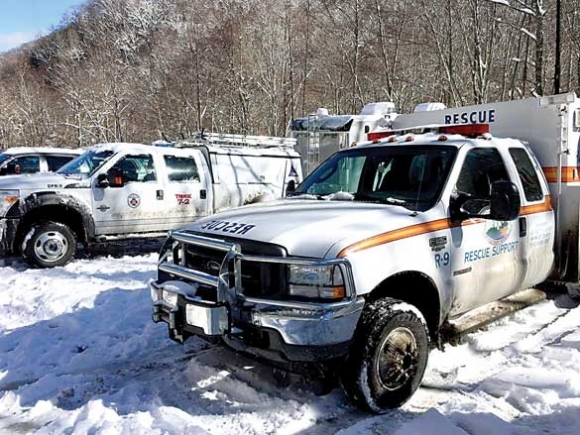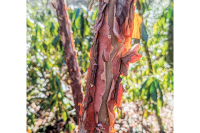Braving the storm: Backcountry rescuers save lost hikers in snow, frigid temps

It was around 12:30 p.m. Thursday, Jan. 5, when the two hikers stepped out of their red Ford Edge and into the parking lot at Big East Fork Trailhead. After the stunning vistas the Blue Ridge Parkway had offered on their drive from Asheville, David Crockett, a 23-year-old UNC Charlotte student, and his friend Sultan Alraddadi wanted to see those mountains up close.
They’d found the hike on AllTrails, an app that outlined an 8.1-mile loop that climbed Chestnut Ridge, continuing west to butt up against the Art Loeb Trail before returning east via the Shining Creek Trail.
The weather was about average for early January, with temperatures in the 40s and skies shifting between clouds and sun. They could do it in a day, they were sure. The pair set off into the woods with a day-hiking setup that didn’t include a map or a flashlight.
Their confidence was soon tested. The route they’d chosen, located in the Shining Rock Wilderness Area, contains some of the toughest terrain in the entire region. The trail up Old Butt Knob, for instance, climbs 2,200 feet in just 1.5 miles. By 5 p.m., the hikers had completed only the first half of the loop.
The loop’s halfway point can be a tricky one to navigate even in the best of conditions. It’s a five-way intersection, and in this particular wilderness area signage is sparse — a deliberate management choice to preserve the place’s remote character. The hikers took the wrong fork, passing by a sign for Flower Gap — part of the Art Loeb Trail — before darkness fell.
8:27 a.m. Friday, Jan. 6. Haywood County 911.
40 degrees. Some flurries.
Mike Street, Haywood County Rescue Squad: So you don’t know where you walked in at?
Related Items
David Crockett: No, I can’t remember.
The night was doubtless a chilly one for the two hikers as they set up a makeshift camp with their scanty provisions, but it was nothing like the coming freeze that weather forecasts had predicted for days.
The sun rose, and they called 911. The call bounced from Henderson County to Buncombe County and through a conference with the Blue Ridge Parkway before it was routed to Haywood County, which handles search and rescue efforts in the Shining Rock Wilderness.
Dispatchers soon realized that this rescue would be anything but routine. The hikers had no idea where they were, couldn’t even remember the name of the trailhead or the road they’d driven to find it. They phone they used wasn’t GPS-enabled and kept pinging to an unrelated address outside Hendersonville.
And it was cold, soon to be colder, with snow on the way.
“We have to think worst-case scenario,” said Greg Shuping, Haywood County’s Emergency Management Director. “The worst-case scenario is these people are very, very lost, it’s going to snow tonight, the temperatures are going to be low and the wind is going to be bad. With that in mind, we want to get these people as soon as possible.”
Street — the dispatcher — of course, didn’t tell Crockett any of that. He just let him know that it would take them some time to get to him, so he and Alraddadi should just hang tight, stay warm — they’d started a fire using the lighter Crockett had with him — and conserve their phone battery.
“It’s going to take us a little while to get things rolling. I don’t want you walking around anywhere,” Street said. “Do not call a friend. Do not waste your battery, because this is going to be the only tether we have.”
10:15 a.m. Friday, Jan. 6. Haywood County 911.
42 degrees. Forecast calls for snow and low temps.
Dispatcher to David Crockett: They’ve got some people down at the bottom there. They’re getting people ready to get into the woods.
Joseph Massie was at work Friday morning when the page went out.
As a member of Haywood’s specialized Mountain Search and Rescue Team, he’s used to juggling obligations at his paying job with the call of duty, but in this instance the stress of having to wind things up at work was coupled with knowledge of what was in the forecast.
His instructions were “be prepared. Be prepared for the worst weather possible.”
Massie heeded the instruction. MSAR members tend to be rather prepared folks. To even be on the team, they must complete 48 hours of training above the 276 hours required to be on the Haywood Search and Rescue Team. In addition, each member of the team must purchase their own cache of personal gear, typically costing about $1,000.
By the time Massie arrived at the trail around 1 p.m., the search was already underway. In addition to the SAR team, the Cruso Fire Department and the Haywood County Sheriff’s Office — lead agency for the incident — were part of the initial response.
Myriad trails spider through the Shining Rock Wilderness area between Big East Fork and Black Balsam, and nobody had any idea where in all that wilderness the hikers might be. But command staff had worked out a strategy, sending different teams out to different areas based on the likelihood of success and the difficulty of a given trail.
With nighttime and worsening weather on the way, however, Shuping knew that the effort would require help. Luckily, that help was on the way. There are four other MSAR teams in North Carolina — based in Henderson, Buncombe, Mitchell and Avery counties — and Shuping had contacted them immediately following the morning’s first 911 call.
As the local crews took step after step in increasingly cold and snowy weather, laden with by 30-pound packs of gear, it was heartening to know that help was on the way. The MSAR teams all did trainings together and had a solid sense of camaraderie.
“When we see them on a search, it’s attitude-bolstering,” Massie said. “It’s yes, alright, I know I’ve got some awesome guys and gals from Buncombe County.”
Or from Henderson. Or Avery. Or Mitchell.
It was midnight by the time Massie came off the trail Friday. But the search didn’t stop when the local folks turned in for the night — the three other crews kept looking.
“By the time we were done, it was late, dark, the snow had really started and we were told to rest and prepare for the next day,” Massie said.
8:11 a.m. Saturday, Jan. 7. Haywood County 911.
12 degrees with 20 mph winds, 40 mph gusts. 6 inches of snow and counting.
David Crockett: This is David Crockett, lost hiker, I talked to someone yesterday. We’re still alive. Barely. But we’re still alive. And nobody’s found us yet.
When hope withers, odds of a successful search do as well. And while nobody had given up hope, exactly, as Friday night gave way to Saturday morning everybody was painfully aware of the facts.
It was cold. It was windy. It was snowy. And the hikers were woefully unprepared for a multi-day ordeal in the wilderness.
Then, the phone call came.
“We never lost hope, but when we heard that phone call from them, that really gave us the morale we needed to step forward and really make this thing happen,” Shuping said.
Massie, waking up from a well-deserved rest between shifts, remembers it the same way.
“Oh my gosh, that call totally bolstered — we were still going in but it helped,” Massie said. “We had daylight and fresh legs and we were like, send us in!”
That’s not to say that all was well on the hikers’ end. They hadn’t eaten since Friday morning, and melted snow was all they had to drink, Crockett told dispatch. They were cold, chilled through. Their legs hurt and they could barely move them.
“We will not last through tonight,” Crockett told dispatch. “There’s no way.”
As the morning progressed, the weather cleared. The sun came out. Air rescue was now an option.
“I cannot say enough about the state mobilizing to make this happen,” Shuping said, acknowledging that they easily could have deemed the mission too dangerous for their pilots.
The Mountain Area Medical Airlift helicopter was first on the scene — the helicopter was already in the neighborhood and spent about half an hour searching the area before being forced to leave and fuel up.
Then came a State Highway Patrol helicopter. Just before 5 p.m. Saturday, Jan. 7, the crew found the hikers using thermal imaging, relaying the coordinates to the N.C. Emergency Management Helo Aquatic Rescue Team, which carried rescue technicians from the Charlotte Fire Department.
The N.C. HART crew arrived just after nightfall and wasn’t able to see the hikers, requiring a third helicopter — a National Guard machine — to relocate them using thermal imaging.
All the while, ground crews were still searching. Sure, a helicopter was on its way, but what if the air rescue didn’t work out?
“We did have that other plan in place,” Shuping said. “Our searchers were going to them assuming it wouldn’t work.”
The snow may have stopped, but the cold hadn’t. And the ground was still covered with a thick blanket of white that made for beautiful scenery but arduous hiking.
“One time the Highway Patrol called in coordinates and we stopped to plot those coordinates,” Massie recalled. “In the three to five minutes I had my gloves off to plot those coordinates, my fingers were purple.”
Which made it easy to wonder: what condition might the hikers be in when they were finally located?
“We check in with command every 30 minutes but during our search we are actively stopping, yelling, looking for smoke,” Massie said. “Visual clues. We had snow so we knew if they were foraging for wood or anything that we would see their tracks.”
Massie’s group never saw any tracks. But another search and rescue crew did, coming upon the hikers in the Greasy Cove area — about 8 miles from the trailhead and 4 miles from the Blue Ridge Parkway — just minutes before the N.C. HART crew made the save.
By 8 p.m., the hikers had been flown to the Asheville Airport and whisked to the hospital by EMS crews. They were discharged the following morning, with no lasting injuries.
The day was not over for the ground rescue crews, however. It was after midnight by the time they’d all managed to hike out of the woods and get home.
“The body can withstand so much more than you think it can,” Shuping said. “You’re not going to be happy and you’re not going to be comfortable, but the body is more resilient than we give it credit for.”
3:08 p.m. Sunday, Jan. 8. David Crockett’s public Facebook post.
“The best part is that I lived to tell the tale.”
After his rescue from an ordeal that easily could have ended in death, Crockett — or, at least, his Facebook page — is brimming over with gratitude.
Crockett wrote that he’s “eternally grateful” for the huge number of people involved in the search and that he appreciates “all the prays [sic] and good vibes from so many friends and family.”
“We made choices and accomplished unimaginable things together, proud of what we did and had to do to survive the wilderness and wicked cold temps,” he continued. “For me, a few scrapes, bruises, 2nd degree frostbite on toes and fingers, and an unforgettable story to tell.”
He followed the post with links to Haywood County Search and Rescue’s donation page.
“There are two men alive today because of the efforts of people who have a heart of servitude,” said Haywood County Sheriff Greg Christopher. “I have never been more proud of a group of folks, many of whom are volunteers, who risked so much to find these men.
The crews certainly deserve every bit of thanks that come their way, Shuping agreed. Amazingly, only one crew member was injured during the search. That person was treated and then released from the hospital for cold weather exposure. But the story could easily have ended differently.
“It’s so heroic that someone would leave their family on the weekend or during the week and spend 12 hours doing a 13-mile hike carrying a 30-pound pack with snowshoes on,” Shuping said. “Where do you find these people? I don’t know. That’s the story to me.”
Be safe
Wintertime in the wilderness can be wonderful, but it can also be dangerous. Before heading for the woods, always remember to:
• Tell somebody where you’re going and when you’ll be back.
• Avoid traveling alone — find somebody to hike with you.
• Research the route before you leave, and always bring a map and compass.
• Dress in layers, and always bring more food, water, and clothing than you think you will need for the planned route. In case of emergency, having extra could be life-saving.
• Bring a GPS-enabled phone and turn it on airplane mode to preserve the battery. Store it close to your body so cold weather won’t sap the battery prematurely.
• Carry a first aid kit, as well as a lighter in case you need to make a fire.
Haywood County Emergency Management offers safety presentations that are available to any group that would like to host one. Greg Shuping, 828.456.2391 or This email address is being protected from spambots. You need JavaScript enabled to view it..
By the numbers
• 120 people representing 40 different agencies assisted in the rescue effort.
• 100 of the 120 responders were volunteers.
• 16 vehicles were used to transport people, provide logistical support or push show.
• 3 full days of winter training last year assured that Search and Rescue volunteers would know what to do in a winter rescue situation.
• $0 is the county’s portion of helicopter costs. The state will foot that bill. The county will incur very little direct expense from the rescue, though the ongoing cost of training volunteers and purchasing rescue equipment is significant.
Support the Haywood County Rescue Squad
New members and donations are always welcome at the rescue squad. The nonprofit organization is run by volunteer members who respond to a variety of calls throughout the year — including those from people lost in the wilderness.
Donate or find out how to join at www.haywoodrescue.org.













